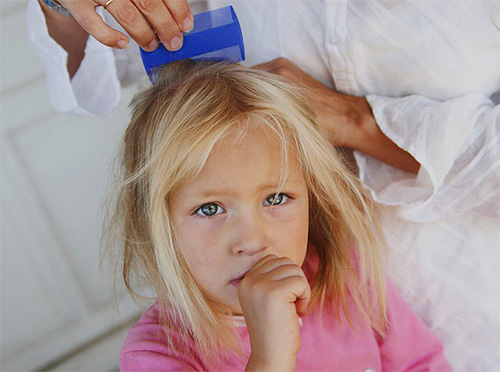
If lice have appeared on the head or body of an adult or child, the symptoms of their appearance do not become noticeable immediately. As practice shows, at first these symptoms are so mild and insignificant that even a person who is very sensitive to his body does not immediately pay attention to them.
However, taking into account the nuances that we will discuss later, signs of the appearance of lice and nits can be detected both in oneself and in another person already during the first few days of infection.

On a note
Infection with lice is called pediculosis - this parasitic disease in its advanced form can lead to serious skin lesions, up to dermatitis and pyoderma. In addition, it should always be remembered that lice are capable of carrying pathogens of serious infectious diseases (for example, deadly typhus), and therefore it is impossible to treat them with carelessness, as if they were just annoying insects.
It is important to keep in mind that it is usually more difficult for an unsuspecting person to detect the parasites themselves than to notice the symptoms of the presence of lice on the head or on another hairy part of the body. Lice are very small insects with a body length of about 2-3 mm, translucent and hiding at the hair roots.
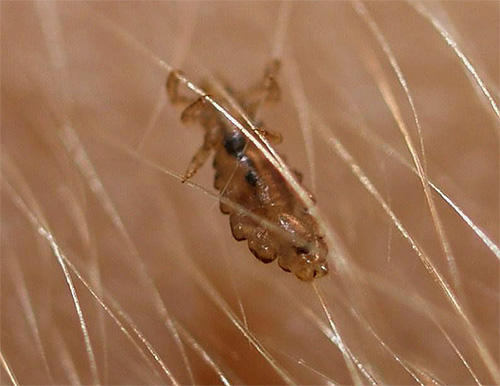
Head, pubic and linen lice are practically the only human parasites that bite precisely on the hairy areas of the body. In this they are easily distinguished from fleas, which bite mainly on the legs, and bed bugs, which leave bites on the sides and back.

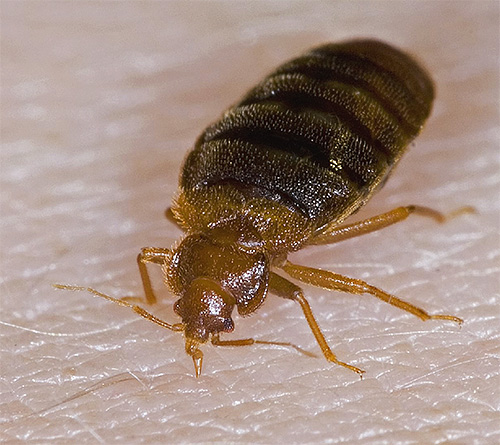
Other characteristic signs of lice:
- light gray, almost white body
- inability to jump
- and lack of wings.
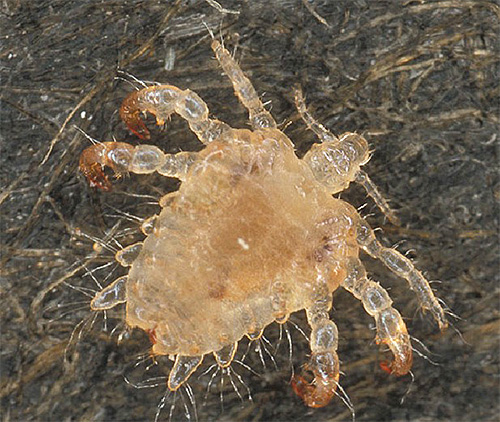
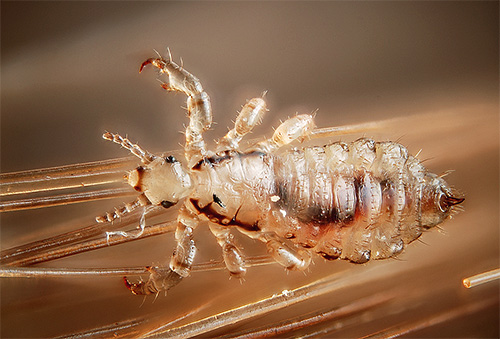
These features are not immediately evident to the eye, but upon closer examination they can be detected even without a magnifying glass.
On a note
The so-called linen louse differs from the head and pubic louse in its tendency to bite hairless areas of the body under clothing. But infection with it today is a much rarer case than infection with the other two types of lice.

The video below describes the symptoms of lice and shows how to detect lice using improvised means:
An interesting video about lice, sources of infestation and methods of control
To detect lice, you must first carefully examine the hair, spreading it with your fingers and assessing the condition of the surface of the scalp. Lice can be either directly on the skin or on the hair a few centimeters from their base. It is also easy to spot nits (white dots on the hair) and red bite marks on the head.
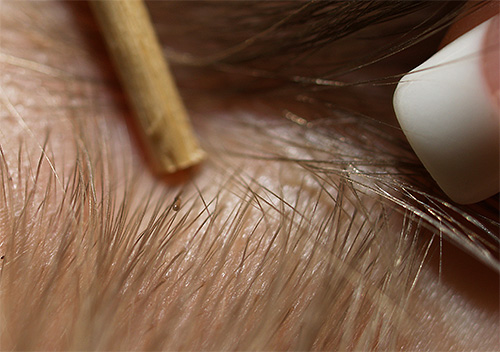
The photo shows the characteristic symptoms of lice in a person at a late stage of infection. Lice and nits are visible to the naked eye here:
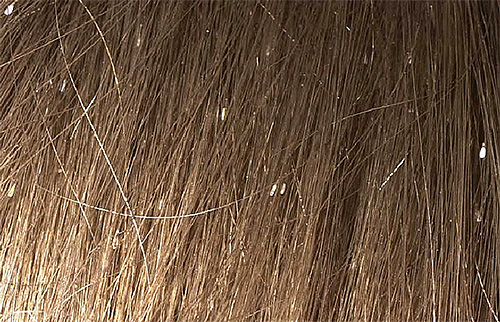
You should also pay attention to the typical signs of a head lice infestation.
Itching on the head
The first signs of lice are always light scratching where the lice bite.The only food of these parasites (both in adult insects and in larvae) is human blood, and in order to get to the blood vessels with their jaws, they pierce the skin and introduce a special secret that prevents blood clotting.
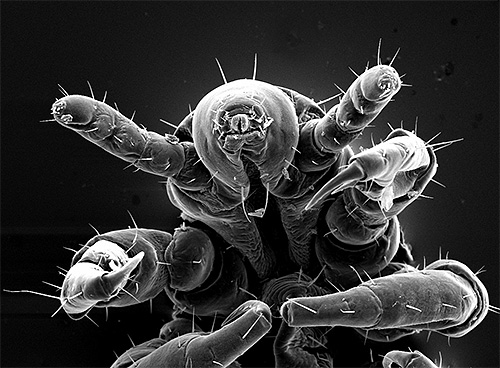
During a bite, a person may feel a slight prick, similar to a mosquito, and when the anticoagulant enzyme begins to act, itching appears.
Usually, when only a few lice bite a person, he does not pay attention to itching. Itching becomes obvious and interfering with feeling normal even when several dozen or more lice appear.
And further: Lice are not cockroaches, so is it worth removing them with Dichlorvos? (the article has more than 20 comments)
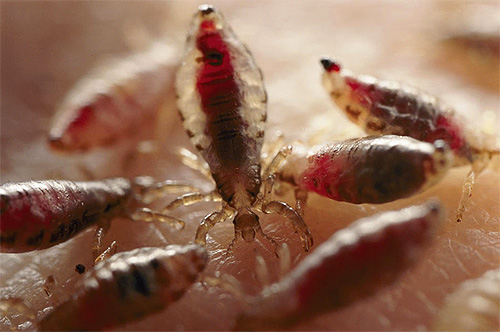
Of all the symptoms of the presence of head lice in the hair, it is itching that attracts attention first - at this time, the parasites themselves, if not carefully examined, may not be noticed, and the skin reaction is also not yet manifested too clearly.
Pay special attention to itching should be in the case when it does not go away after washing the head and torments at night. This is a clear sign that it is caused by parasites or other skin problems.
Itching in another person, especially a child, is recognized by characteristic changes in behavior: the infected person constantly scratches his head, straightens his hair, combs it with a comb, and pulls.
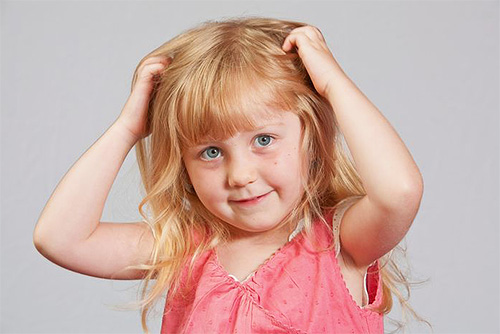
Babies in this case become very capricious and constantly cry for no apparent reason.
On a note
Attention should also be paid to the specific behavior of a potentially infected person in public places.Even if the lice themselves are not visible to him, it is simply dangerous to approach him - lice can be infected by contact with clothing, by accidentally shaking off hair. If a schoolchild complains about a classmate constantly scratching his head, it makes sense to report this to the school first-aid post and the class teacher.
Regular itching at the causative site from pubic lice is a much more obvious symptom of infection with them (compared to the itching caused by head lice - after all, the head can itch even from nervous disorders). Fortunately, the owner of the parasites can immediately examine the pubic hair and immediately make a correct diagnosis.
Constant irritations, bites and their consequences
Also obvious and easily detectable symptoms of the appearance of lice are traces of their bites on the skin. As a rule, these are small dotted redness, each with a small, closed hole in the middle. These bites are very similar to flea bites.
With severe infestation, lice bites merge into large redness and can even protrude beyond thick hair. Such symptoms of lice on the head are especially clearly visible - the patient's skin becomes similar to that of dermatitis:
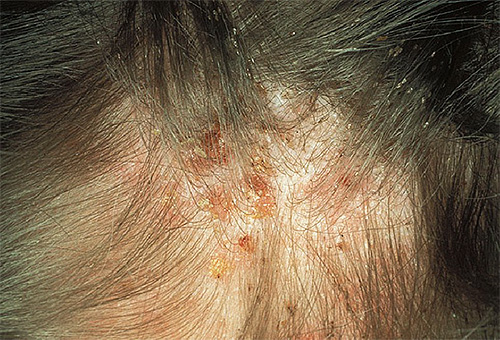
As a rule, with multiple bites, a person constantly scratches itchy areas, which leads to the appearance of excoriations - characteristic scratches that occur when the nails damage the upper layer of the skin. They quickly become covered with crusts and become clearly visible. These signs of lice can often be observed in vagrants:
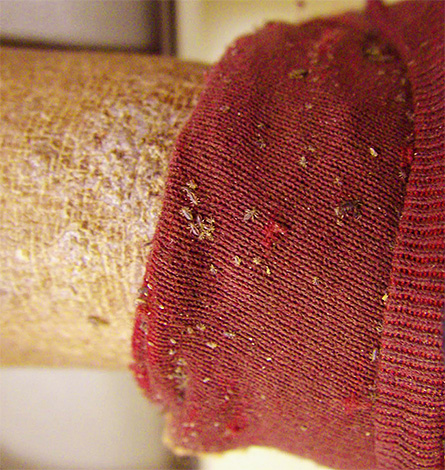

Characteristic symptoms of the presence of lice are also bluish-gray spots on the skin in places of constant biting. There is nothing dangerous in these spots, but they clearly indicate pediculosis.
Complications of pediculosis as symptoms of lice
Finally, if the first signs of the appearance of lice have gone unnoticed, complications developing on its soil may indicate pediculosis:
- pustular skin lesions in places of scratching and secondary infection;
- pyoderma;
- nervous disorders associated with constant itching;
- sleep disturbances and phantom visions of crawling insects.
As a rule, such symptoms of lice develop in the most advanced cases and are typical mainly for homeless people. In children or hygienic adults, these signs usually do not come to the fore.
In rare cases, lice bites can develop an allergy.

It is difficult to distinguish it from other types of allergies and it is impossible to consider rashes on the body as a reliable sign of the presence of lice. However, if, in parallel with itching, rashes appear on the skin, and even more so generalized allergy symptoms in the form of fever and swollen lymph nodes, you should definitely check the hairy areas of the body for the presence of lice.
Hair bonding and tangles
In cases where pediculosis develops in conditions where it is impossible to wash your hair regularly (camping and expeditionary conditions, military operations, vagrancy), their rapid sticking together and the formation of tangles become a characteristic symptom of lice in the hair.
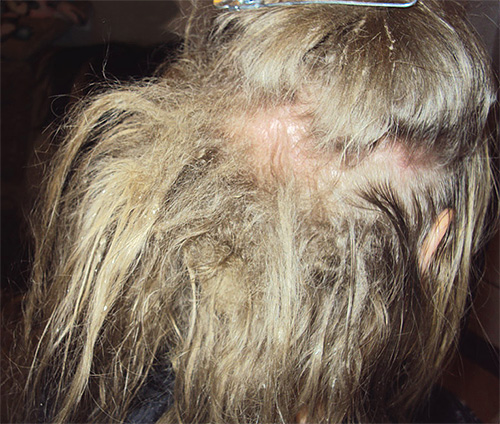
This is due to the fact that in order to attach the egg to the hair, the female envelops the hair with a sticky secret that ensures reliable adhesion of the nits. If the insect at the same time holds on to several hairs, they all stick together.With a serious infection, the number of such sticky hairs becomes very large, and so-called tangles appear.
On a note
The skin under such tangles itches not only because of lice bites, but also because of the accumulation of dandruff and the lack of normal ventilation. In addition, without regular combing, the hair rolls without lice, but as an additional symptom of the presence of head lice, this symptom can be taken into account.
Nits and waste products of parasites
Nits can be attributed to the symptoms of head lice even more pronounced than lice bites and constant itching. It is impossible to confuse them with anything.
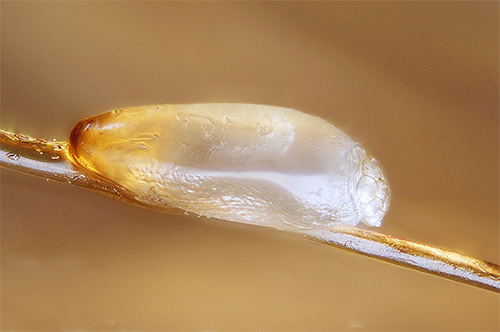
Nits are lice eggs in special protective shells that are firmly attached to the hair. It is nits, not lice, that are the first to catch your eye when looking at an infected head - they look like small white dots located at different distances from the hair roots. Nits are most noticeable in people with dark hair.
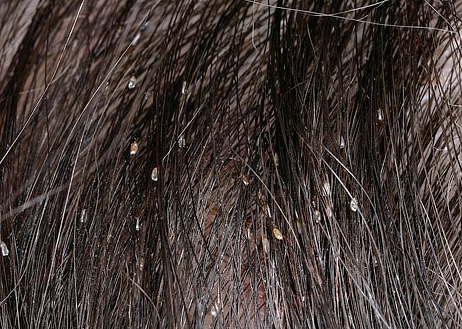
Important
Empty white shells of nits (so-called dry nits) remain on the hair long after the larvae themselves hatch from them. Accordingly, the longer lice are present on the head, the more noticeable the nits will be. In the most advanced cases, the hair of an infected person looks like it is sprinkled with white groats.
Lice excrement looks like small dark dots no larger than a few tenths of a millimeter in diameter. It is very difficult to notice them individually, but if they crumble from the head onto a sheet or pillow, then in their mass they become very noticeable.
They can also be found when spreading the hair with your fingers - both the shells of nits and the excrement of lice here will look like foreign debris.The shells of nits of linen lice are especially clearly visible on dark clothes - this type of lice spends most of its life on things.
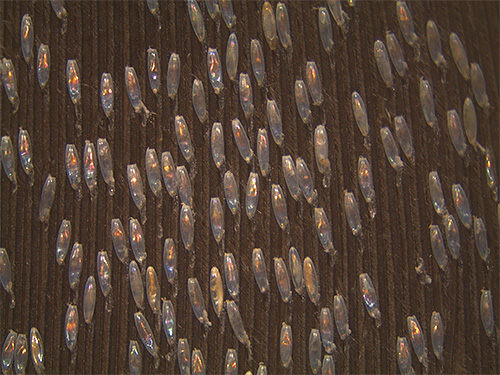
It is worth knowing the symptoms of lice not only in order to start the right treatment on time, but also for the purpose of prevention - if there is a person in a public place who constantly scratches his head and has characteristic redness on the skin near his hair, and even more so, he has a noticeable "snowball" from nits, you should stay away from him. Similarly, you can easily identify a "lousy" child in the children's team and take timely measures to ensure that your own child does not become infected from him.
Important information about lice infestation and how to get rid of them safely

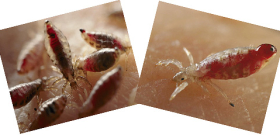
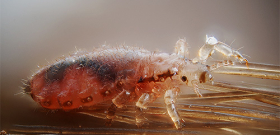
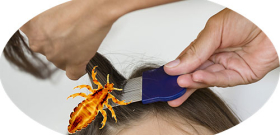
The sight is not for the faint of heart, of course! We also encountered the problem of lice when the child was in the camp. Not on such a scale, of course, but the nurse missed the outbreak of pediculosis.Where this infection came from is unknown. We took ours home right away. I immediately called a specialist to the house, and he brought all the parasites to the child in one session. He smeared his head with a special balm and carefully combed everything out with a metal comb. The scallop then remained with us, the specialist explained how to use it correctly. It is also good for prevention, so that the disease is immediately detected and not started.
What a nightmare it is, I already have no strength and it’s so scary that goosebumps! Mom and I will soon be shaking. How tired it is, horror!
Horror
Nyuda spray helped us, I'm happy with it))
Nyuda spray helped us too!
And I took out diesel fuel, the effect is colossal!
And we deduced dichlorvos in general! You spray your head with dichlorvos, under the bag for an hour and then wash it off. You repeat the procedure in a week. Gone within a week.
I have read the reviews! I would not even have thought of using dichlorvos, and diesel fuel too. Now there are many effective and safe means for health.
Kapets!
Well, in general, I had 13 lice, sprinkled with pediculene - and you're done.